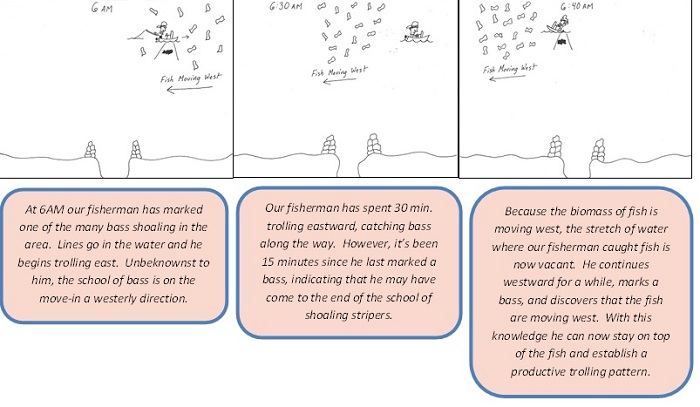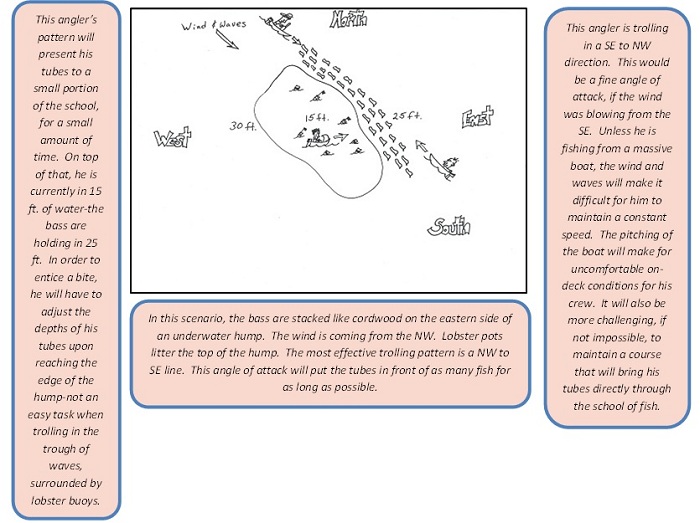When I first began trolling the tube and worm, I did not put much thought into my trolling pattern. I’d typically be excited to have just found some bass, and would troll around in circles, through the general area where I had marked fish.
Just a few years ago I remember returning to the dock after what I believed to have been a successful trip. I had caught a few nice bass and was pretty satisfied, until I heard the news at the dock. A couple sharp striper anglers had severely out fished me, using the same techniques in the same area that I was fishing.
Those guys out fished me not because of luck, some secret technique or special mojo. They out fished me because they had implemented an effective trolling pattern that put their tubes in front of more bass in less time, contrasted to my experience.
Looking back it’s no surprise that trolling in circles was not the most efficient use of my time, gas and efforts. Having tubes in the water when there are fish around is always a good thing, but if you want to take your tube and worm success to the next level, then it is important to develop a strategic trolling pattern.
Being smart about how you troll through an area holding fish is often the most overlooked, yet important facet to having a banner day. In this section I will break down my trolling pattern strategy for a variety of situations that I typically encounter while on the water.
Remember that this is just how I like to do things. There’s obviously no right or wrong way to catch a fish!
Identifying Bass Behavior
After locating a fishy area, the next thing I try to do is determine bass behavior. Below are questions I ask myself after finding some fish:
1) Are the bass shoaling or schooling?
This is generally an easy behavior to figure out. If I mark large “piles” of tightly packed bass, then the fish are in schooling mode. If I am marking individual bass spread out amongst a large area, then the fish are shoaling.
2) Are the bass moving in a certain direction?
This question is more difficult and often requires more time to figure out. To answer this question I’ll either use the 15 Minute Rule or a Run and Gun technique-which I’ll explain later in this section.
3) Are the bass located throughout a vast stretch of water, or concentrated in one area?
Again, I answer this question using the 15 Minute Rule or the Run and Gun technique.
The 15 Minute Rule
I use the 15 Minute Rule most often when bass are shoaling, or spread out amongst a large expanse of water. Maybe I am marking bass that are suspended in deep water, or maybe they are on the feed along a long stretch of beach. Either way, when fish are spread out throughout a large area, the 15 Minute Rule has proven itself as an efficient tool for developing a successful trolling pattern.
The strategy works like this. Upon marking even one bass I will then put lines in the water. I will begin trolling in a chosen direction, almost always parallel to the beach. This way I troll along the depth at which I marked that initial bass. I am placing a bet that the single bass I have marked, is but one of many bass in the general area.
I will then troll for 15 minutes, keeping a close eye on the sonar the entire time. If after 15 minutes I have not enticed a bite, caught a fish, or marked more bass on the sonar, I resume my search parallel to the beach along the same depth until I begin marking fish again.
If I do catch a bass during the first 15 minutes, entice a hit, or mark more bass on the sonar, then my 15 minute clock is reset.
Essentially, I continue trolling in the chosen direction until the area “dries up.”
In the past, a typical scenario I’ve encountered is finding a stretch of water, up to a mile in length, which has held bass along the entire stretch. The areas to the east, west, north and south of this stretch of water often contain no life at all.
The 15 Minute Rule helps me to distinguish the productive stretch of water in the following way.
Let’s say I have been catching fish consistently on the troll for the past half hour. During the past half hour I have trolled a relatively straight course eastward through a half mile stretch of water. It’s now been 15 minutes since I have caught a bass, enticed a bite, and marked anything on my sonar-indicating that I have come to the end of the productive stretch of water.
The next step would be to reel the lines in, and motor westward, back to where I began marking, and catching fish. I’d keep a close eye on my sonar while motoring, noting any bass marks that may appear.
If I mark bass on my westward trek back to where I initially began marking fish then great, the fish are still holding along the same stretch of water. I would then put lines back in, and troll the same pattern I had initially trolled through the fishy area.
If I do not mark any bass during my trek westward, then I would continue motoring further west. I’d continue motoring west for up to a mile, keeping a close eye on the sonar the entire time. Often I will begin to mark bass just west of where I had initially found them, indicating that the biomass of fish is moving in a westward direction. If sea conditions permit, I would then put lines in the water, and begin trolling westward. If sea conditions do not allow this, I would then continue motoring west until I stop marking bass, turn around, and troll eastward through this newfound fishy stretch of water.
Of course there will be those times when I do not mark bass during the trek westward. And upon motoring up to a mile west of the initial spot where I first began marking fish, I will still fail to mark any life on the sonar. In moments like this I would assume that the biomass of bass has moved either shallower or deeper.
I can assume with relative confidence that the bass have changed depths due to a few important observations. The first is that I stopped marking them at the end of my initial eastward troll. I then also failed to mark any bass during my trek west, back through the once fishy stretch of water. Finally, after venturing up to a mile west of the initial spot where I first began marking bass, I still failed to mark any life on the sonar.
Thus I would conclude that the bass have moved either shallower or deeper. I would then move into shallower or deeper water, and begin a completely new search pattern.
Run and Gun
When bass are schooled up, there will often be large, individual schools of bass spread throughout a large expanse of water. There could be one school of a hundred bass holding in 50 feet of water, and then another equally large school holding in 50 feet of water a quarter mile or more down the beach. Sometimes there will be many schools dotted throughout a mile or longer stretch of water. Either way, the concept to grasp here is that if you have found a large school of tightly packed fish, odds are that there are more schools of bass exhibiting the same behavior in close proximity to the school under your boat.
For me, trolling when bass exhibit this behavioral pattern typically plays out like this.
I’ll troll through a large school of bass. If the fish are biting, one or more rods will double over. We’ll enjoy a quick flurry of activity until the school moves on. I’ll continue trolling in my chosen direction. I’ll experience a lull in activity and life on the sonar, solely because of the way the bass are behaving.
What I mean by “solely because of the way the bass are behaving” is that due to the fact that all the fish in the area are balled up in tight schools, there is more water in the general area that is completely vacant of fish.
In other words, when bass are shoaling, many fish are spread out rather evenly across a large expanse of water. When bass are schooling, many fish are located in a very small amount of water. Trolling through an area in which bass are schooling, results in quick flurries of action while you have the school under your boat. If you continue trolling along, it may be a while until you stumble upon the next large school. If you are lucky, you will stumble upon the next large school and enjoy another quick flurry of activity, followed by another lull.
Because of how the bass are behaving, the 15 Minute Rule is not the most effective approach in this scenario. Trolling, in my opinion, is also not the most effective approach to catching bass that are balled up in tight schools.
I instead prefer to get the boat up on plane and cruise at 20-25mph through the fishy area until I mark a large school of bass. Upon marking a large school of bass, I will then whip the boat around, and pitch live baits or cast artificial baits on top of the school. Time is of the essence in this scenario. By the time lines are set for the troll, the large school of fish will often have already moved out of the area.
I explain this technique further on the My Fishing Cape Cod blog. Just click here to visit the blog and learn more about running and gunning. Because I often do not use the tube and worm in this scenario, I’m not going to elaborate on run and gunning at the moment.
Working Structure
One of the most ideal scenarios for trolling the tube and worm occurs when bass are holding tight to a piece of structure. This could be a rip, a ledge, a shoal or really anywhere where bass remain stationary for an extended period of time.
Developing the most efficient trolling pattern in this scenario requires proficient use of sonar, as well as GPS technology.
When I find bass stacked up along a drop-off, ledge, shoal or rip, I will mark the spot as a waypoint on my GPS. I’ll then develop an angle of attack depending on current, wind, waves and obstructions like buoys and other boats. The goal here is to develop a repeatable trolling pattern that will put the tubes in front of as many bass as possible for as long as possible.
In the diagram on the following page, the most effective angle of attack would be from the northwest to the southeast. Due to the wind, waves, current, obstructions and location of the bass, the trolling pattern described in the diagram is the most efficient pattern possible.
All other variables held constant, the angler trolling from a NW to SE direction will out fish the other two anglers. Back at the dock, the other two anglers may be puzzled as to why they were out fished. Everyone was using the same technique, in the same exact spot.
The ability to develop a repeatable, productive trolling pattern is what sets proficient tube and worm anglers apart from the crowd.
For more in-depth information about trolling the tube and worm for striped bass, check out Tube and Worm Trolling-from the first knot to the gaff shot! Just click here.
Tight lines and good luck!
Captain Ryan


